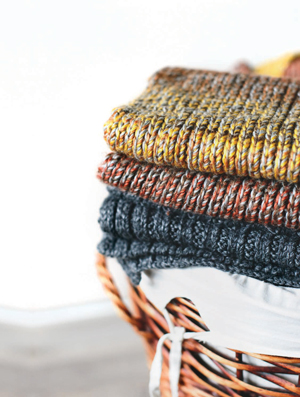Caring for Winter Textiles | Laundry Tips for Items that Keep Us Toasty

My high school years were spent in Ohio where my family lived in an old, drafty house. If I ever complained about being cold, I was told to “put another layer on.” This might consist of another wool sweater or knitted throw or blanket. My grandmother knit all of her grandchildren beautiful sweaters in Scandinavian patterns, and my mother knit and crocheted blankets. In the spring, my mother enlisted my help laundering all these woolens. We’d fill up a sink or tub with cool water, add Woolite, and let them soak. Then we’d rinse them, roll them in towels, let them dry on radiators, then tuck them away in a chest with moth balls.
 The winter textiles around your home that keep you warm and toasty need a little TLC too before packing them away for the season. While it is always important to check laundering labels, unless something specifically says “dry clean only,” many of your cozy home items—blankets, throws and comforters—can be cleaned safely and inexpensively at home or at a laundromat.
The winter textiles around your home that keep you warm and toasty need a little TLC too before packing them away for the season. While it is always important to check laundering labels, unless something specifically says “dry clean only,” many of your cozy home items—blankets, throws and comforters—can be cleaned safely and inexpensively at home or at a laundromat.
Annual end-of-season laundering will help keep these textiles in good shape. Avoid top-loading machines with agitators, as they twist large items and result in lumpiness before the drying process can occur. Cotton, fleece and acrylic blends can be washed in cool water and dried on a low setting. It is best to wash each item separately to avoid shedding or tangling, which can damage the appearance and shape of the item.
 Wool is a staple in the world of warm, natural fabrics and is available in a variety of forms including lambswool, merino, shetland, mohair, angora and cashmere. Wool has a natural layer of lanolin and requires a gentle detergent. Avoid heavy-duty detergents, especially ones containing enzymes or bleaches. Enzymes are proteins that break down stubborn stains and are listed as “bio-based.” Wool should never go in the dryer; rather, stretch your wool over one or two drying racks or air dry outside on a sunny day. Even cashmere, the most expensive and delicate material, can often go in the washing machine; just use a mesh lingerie bag to protect it.
Wool is a staple in the world of warm, natural fabrics and is available in a variety of forms including lambswool, merino, shetland, mohair, angora and cashmere. Wool has a natural layer of lanolin and requires a gentle detergent. Avoid heavy-duty detergents, especially ones containing enzymes or bleaches. Enzymes are proteins that break down stubborn stains and are listed as “bio-based.” Wool should never go in the dryer; rather, stretch your wool over one or two drying racks or air dry outside on a sunny day. Even cashmere, the most expensive and delicate material, can often go in the washing machine; just use a mesh lingerie bag to protect it.
Larger winter textiles such as comforters or quilts can also be washed at home in a front loader. If your piece is very bulky, it would be wise to use the industrial-size machines at a local laundromat. Just like laundering wool, use a gentle detergent. Down comforters and quilts can go in the dryer. Wool dryer balls are recommended for drying such large items; the dryer balls bounce inside the dryer drum, creating loft for better air flow and quicker drying. The wool balls will help feathers in comforters return to their original fluffiness and protect batting in quilts from lumping. If you like scented dryer sheets, try adding a few drops of your favorite essential oil to the balls instead.
 For the real down and dirty
For the real down and dirty
Folklore tells us that during Prohibition in the 1920s, bathtub gin was all the rage. Fast forward to 2021, and people are laundering in their tubs. With so much time spent at home during the pandemic, many people have looked around and noticed things that need to be tidied, organized or cleaned. Laundry stripping—a process that involves soaking it in a bathtub with a mixture of powdered borax, washing soda (sodium carbonate) and powdered laundry detergent—has been making a comeback. Mothers who used cloth diapers are probably familiar with the technique, but it has made a resurgence thanks to social media. Essentially, laundry stripping is a method of washing that aims to remove detergent residue, fabric softener, minerals from hard water, and body oils that have collected on your laundry over time. Since towels and sheets are used daily and washed frequently, they develop residue that dulls or yellows them. Soaking laundry in hot water with this solution (¼ cup borax, ¼ cup washing soda, and ½ cup powdered detergent) strips the fabric of this residue. This process works best on white sheets and towels; the solution can cause colors to run and damage delicate fabrics. After soaking for four to six hours, launder and dry your sheets and towels as you regularly do, but without detergent.
For textiles with stains, try a spot treatment of a dab of detergent applied directly to the stain then rinsed off after a few hours. Seriously stained pieces should be taken to a professional dry cleaner. As with all items that have been dry cleaned, remove the plastic when you get home. The chemicals used in dry cleaning need to be ventilated. Store your clean winter blankets and comforters in cotton or muslin bags in a climate-controlled area of the house. If your home is prone to pests or insects, toss in a few cedar chips or lavender sachets. Plastic storage containers are fine as well; just make sure your items are completely dry before packing away.
Proper care and storage will ensure a longer life of your favorite winter textiles, as well as provide a satisfying ritual for spring cleaning. In fact, a favorite sweater of mine, carefully laundered over the years, was passed down to my younger siblings and then to both my children. I have four of those sweaters safely packed away for future grandchildren. ✦
acrylic blends, angora, blankets, cashmere, comforters, cotton, dry clean, fleece, lambswool, lanolin, Laundry stripping, Laundry Tips, merino, mohair, shetland, throws, Winter Textiles, wool, woolens






